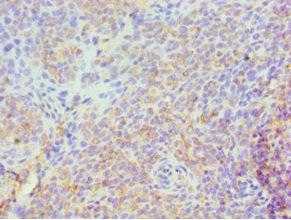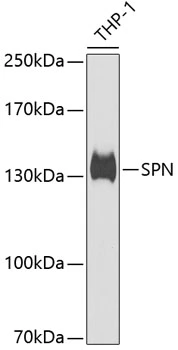![FACS analysis of PBMCs using GTX34507 CD43 antibody [SPM503]. Red : Primary antibody Green : Isotype control FACS analysis of PBMCs using GTX34507 CD43 antibody [SPM503]. Red : Primary antibody Green : Isotype control](https://www.genetex.com/upload/website/prouct_img/normal/GTX34507/GTX34507_20200115_FACS_1671_w_23060801_963.webp)
FACS analysis of PBMCs using GTX34507 CD43 antibody [SPM503]. Red : Primary antibody Green : Isotype control
CD43 antibody [SPM503]
GTX34507
ApplicationsFlow Cytometry, ImmunoFluorescence, Western Blot, ImmunoCytoChemistry, ImmunoHistoChemistry, ImmunoHistoChemistry Paraffin
Product group Antibodies
TargetSPN
Overview
- SupplierGeneTex
- Product NameCD43 antibody [SPM503]
- Delivery Days Customer9
- Application Supplier NoteWB: 1-2microg/ml. ICC/IF: 1-2microg/ml. IHC-P: 1-2microg/ml for 30 minutes at RT. FACS: 1-2microg/106 cells. *Optimal dilutions/concentrations should be determined by the researcher.Not tested in other applications.
- ApplicationsFlow Cytometry, ImmunoFluorescence, Western Blot, ImmunoCytoChemistry, ImmunoHistoChemistry, ImmunoHistoChemistry Paraffin
- CertificationResearch Use Only
- ClonalityMonoclonal
- Clone IDSPM503
- Concentration0.2 mg/ml
- ConjugateUnconjugated
- Gene ID6693
- Target nameSPN
- Target descriptionsialophorin
- Target synonymsCD43, GALGP, GPL115, LEU-22, LSN, leukosialin, galactoglycoprotein, leukocyte sialoglycoprotein, sialophorin (gpL115, leukosialin, CD43)
- HostMouse
- IsotypeIgG1
- Protein IDP16150
- Protein NameLeukosialin
- Scientific DescriptionThis gene encodes a highly sialylated glycoprotein that functions in antigen-specific activation of T cells, and is found on the surface of thymocytes, T lymphocytes, monocytes, granulocytes, and some B lymphocytes. It contains a mucin-like extracellular domain, a transmembrane region and a carboxy-terminal intracellular region. The extracellular domain has a high proportion of serine and threonine residues, allowing extensive O-glycosylation, and has one potential N-glycosylation site, while the carboxy-terminal region has potential phosphorylation sites that may mediate transduction of activation signals. Different glycoforms of this protein have been described. In stimulated immune cells, proteolytic cleavage of the extracellular domain occurs in some cell types, releasing a soluble extracellular fragment. Defects in expression of this gene are associated with Wiskott-Aldrich syndrome. [provided by RefSeq, Sep 2017]
- Storage Instruction-20°C or -80°C,2°C to 8°C
- UNSPSC12352203

![ICC/IF analysis of K562 cells using GTX34507 CD43 antibody [SPM503]. Green : Primary antibody Red : nucleus ICC/IF analysis of K562 cells using GTX34507 CD43 antibody [SPM503]. Green : Primary antibody Red : nucleus](https://www.genetex.com/upload/website/prouct_img/normal/GTX34507/GTX34507_20200115_ICC-IF_1507_w_23060801_420.webp)
![IHC-P analysis of human spleen tissue using GTX34507 CD43 antibody [SPM503]. IHC-P analysis of human spleen tissue using GTX34507 CD43 antibody [SPM503].](https://www.genetex.com/upload/website/prouct_img/normal/GTX34507/GTX34507_20200115_IHC-P_1162_w_23060801_117.webp)
![WB analysis of K562 cell lysate using GTX34507 CD43 antibody [SPM503]. WB analysis of K562 cell lysate using GTX34507 CD43 antibody [SPM503].](https://www.genetex.com/upload/website/prouct_img/normal/GTX34507/GTX34507_20200115_WB_1492_w_23060801_308.webp)


![WB analysis of isolated peripheral blood lymphocytes (non-reducing) using GTX29088 CD43 antibody [MEM-59]. Lane 1: human PBL lysate Lane 2 : dog PBL lysate Lane 3 : pig PBL lysate](https://www.genetex.com/upload/website/prouct_img/normal/GTX29088/GTX29088_20191025_AP_001_224_w_23060722_883.webp)

![IHC-P analysis of diffuse large B cell lymphoma tissue using GTX01920 CD43 antibody [MT1]. Note the intense staining of malignant CD43: clone MT1](https://www.genetex.com/upload/website/prouct_img/normal/GTX01920/GTX01920_20200811_IHC-P_22_w_23053121_905.webp)